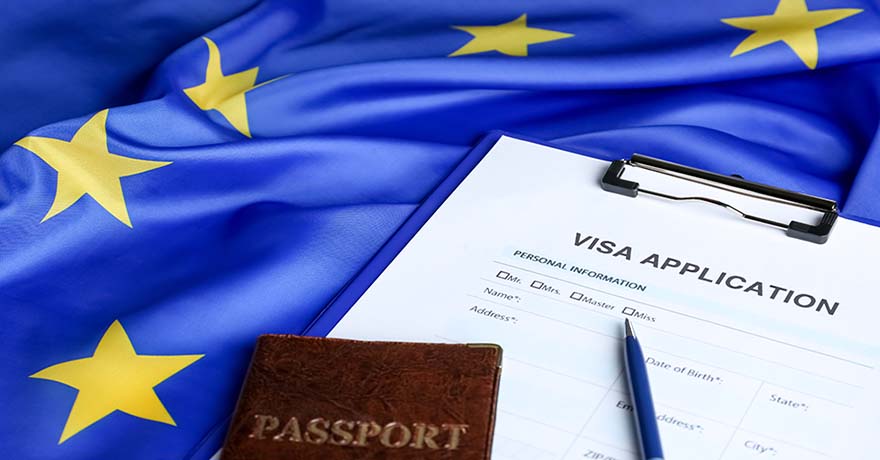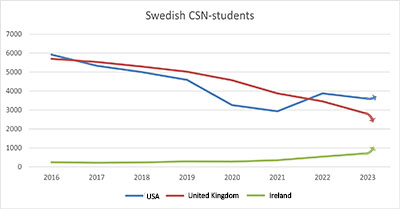How to get a student visa to the European Union
If you're an international student from a non-EU country looking to study in the European Union (EU), you'll need to obtain a student visa. Here is a step by step guide.
1. Apply and get accepted to a school in the European Union
2. Determine What Type of Visa You Need
3. Gather the Required Documents
4. Submit Your Visa Application
5. Wait for your visa to be processed
6. Arrive and register with local authorities
Final note on EU-student visas
1. Apply and get accepted to a school in the European Union
You cannot apply for a student visa until you are accepted to a school in Europe. We and our partners can help you to choose and apply to selected schools and universities in the European Union including all universities in Ireland and Spain. Fill out our information request form to get help.
2. Determine What Type of Visa You Need
The type of visa you'll need depends on your nationality and the length of your course. Students from the European Union don’t need a visa to study in another EU-country, but you might need to register with the local authorities.
Non-EU students who are planning to study for less than 90 days, usually need to apply for a short-term Student Schengen Visa, which is designed for students who plan to study in the EU for up to 90 days.
For courses longer than 90 days will require a long-term student visa at the embassy of the respective country. Some countries also have specific visas for language courses or research programs, and some nationalities might be exempt from visas to certain EU-countries.
The European Union consists of many different countries and each country has its own visa application process and requirements for long term study visas, so the next step is to research the specific visa requirements for the country where you'll be studying. Check with your chosen university or the embassy of the country you plan to study. It is important to do your research early to ensure you have enough time to prepare your application.
In this article we will focus on long term student visas to the European Union and provide you with more specific information on the student visa process to four specific EU-countries: Ireland, Germany, Spain, and Sweden.
3. Gather the Required Documents
The documents you'll need for your student visa application will vary depending on the country you're applying to. However, most countries require the following:
- A valid passport
- Proof of acceptance to a recognized educational institution
- Proof that you can finance your studies and living costs (i.e. bank statements – see amounts below)
- A study abroad insurance
- A criminal record certificate
- Proof of payment of visa fees
- You might also need to show other documents such as proof of language proficiency
4. Submit Your Visa Application
The application process for a student visa can be quite lengthy, so it's important to start early. Once you have gathered all the required documents, you can begin the visa application process. This usually involves filling out an online application form and submitting it, along with the required documents, to the embassy or consulate of the country you'll be studying in. This might also include a visa interview.
Here are links to the application forms and further instructions in our selected countries:
- Germany: citizens from the US, Canada, Australia and some other countries don’t need a visa to enter Germany as a student, but you must apply for a residence permit (see below).
- Ireland
- Spain:
- Choose your country on the map
- Click on the closest Embassy or Consulate
- Click on the link Consular services in the yellow field on the top of the site
- Click on the link labelled Study visa
- Sweden
5. Wait for your visa to be processed
After submitting your application, you'll need to wait for your visa to be processed. The processing time varies depending on the country, but it can take several weeks to a few months. Once your visa is approved, you'll be notified by the embassy or consulate, and you can collect your visa in person or have it mailed to you.
6. Arrive and register with local authorities
Your student visa will show the validity dates From (the first date of entry) and Until (the day you must leave the country if you have not renewed your visa). Make sure that you don’t arrive too early, you will not be allowed to enter the European Union until your student visa becomes valid.
Once you arrive you usually need to register with local authorities:
- Germany: you must register with the local registration office (Einwohnermeldeamt) and apply for a residence permit at the local Foreigners' Registration Office (Ausländerbehörde).
- Ireland: you must register with the Irish Naturalisation and Immigration Service (INIS) to obtain a residence permit.
- Spain: you must register with the local police station (Comisaría de Policía) to obtain a residence permit card.
- Sweden: you must register with the Swedish Tax Agency to receive a Swedish personal identity number and obtain a residence permit card.
Proof of financial support
To obtain a student visa, you need to provide proof that you have enough financial support to cover your living expenses and tuition fees while studying in the EU. The amount needed for this varies from country to country. Here's a breakdown of the minimum amounts that you currently need to show that you have for living costs in the four countries we're focusing on:
- Germany: €11 208 per year
- Ireland: €7 000 per year
- Spain: €600 per month/ €7 200 per year
- Sweden: SEK 9 450 per month (about 845 Euro/month)
On top of this you also need to prove that you can pay the tuition fees if you have not already done so. You can provide proof of financial support in various ways, such as bank statements, scholarship award letters, or a letter from your sponsor. In some countries, like Germany, this money has to be placed into a blocked account.
Visa fees
There is usually a fee for applying for a student visa, and this fee can vary depending on the country you're applying to. Here are the visa fees for the four countries we're focusing on:
- Ireland: €60 for most students (100 Euro for multiple entry)
- Germany: €75
- Spain: €67-150 depending on your nationality
- Sweden: SEK 1 500 (about 135 Euro)
Again, these fees are subject to change, so be sure to check the latest information before applying.
Final note on EU-student visas
Obtaining a student visa to the European Union can seem like a daunting task, but by following these steps and doing your research, you can make the process smoother and increase your chances of success. Remember to start early, gather all necessary documentation, and be prepared for any fees and waiting periods. Good luck on your journey to studying in the EU!
Please note that it is hard to make a complete guide about student visas to the European Union since the rules differ depending on your nationality and the country you want to study in. The costs and regulations can be changed at any time without our knowledge so make sure to do your own research and follow the instructions on the official websites.
More information
You might also be interested in our articles study in Europe and student visa to the United Kingdom.
Follow @dreamstudiesabroad on Facebook, Instagram, Tiktok, or Youtube to get updated about our new schools and articles.






















